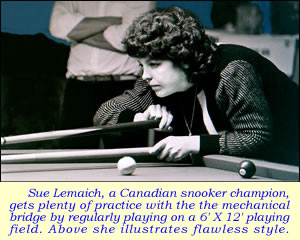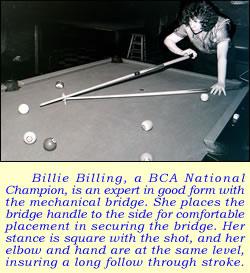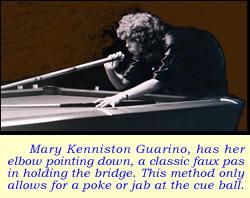.....When I was learning how to play
pool there were no books, no videos, no instructors and no leagues
to play in. The best way to learn was to watch. I was privileged
to see some of the greatest and some of the not so great. My
purpose for publishing my pointers insrtuctional column is not
only to inpart pool knowledge to my viewers but to share with the
public what these great players from the 1980s and 1990s looked
like. Through my trusty Canon, for a moment in time they are immortalized.
Some are still here and some are gone and I still remember the
joy of watching them play.

MECHANICALLY INCLINED
Proper use can bridge crevasses in your game
.....THE MECHANICAL
bridge is one of the pool player’s most
valuable tools, yet it is widely feared, even by professionals.
.....It’s no coincidence that two of the best photographic
subjects on the “substitute” bridge are Sue LeMaich,
a Canadian Snooker title holder,  and
the legendary Irving Crane. LeMaich, who usually plays on a 6’ x
12’ snooker table, gets
lots of practice with the bridge and realizes the value of good
technique for positioning purposes. Crane is from the “old
school”, where they honed their skills on a 5’ x 10’ tables,
and where good basics were a strict discipline. Notice in the photographs
that both adhere to the following principles. and
the legendary Irving Crane. LeMaich, who usually plays on a 6’ x
12’ snooker table, gets
lots of practice with the bridge and realizes the value of good
technique for positioning purposes. Crane is from the “old
school”, where they honed their skills on a 5’ x 10’ tables,
and where good basics were a strict discipline. Notice in the photographs
that both adhere to the following principles.
.....Face the shot squarely, rather than from our usual sideways
stance. Slightly bend both knees for comfort and to lower yourself
for aiming at the shot. Place the mechanical bridge flat on the
table and hold it down with your hand for stability as demonstrated
by Billie Billing. One exception to this form, revealed by Sue,
is that sometimes the player has to hold up the end of the bridge
to maneuver around object balls that are in the way.

.....One of the secrets for acquiring accuracy while using the
bridge is keeping the cue stick level and immobile. Adjust the
height of the tip, where you want to strike the cue ball, by drawing
the bridge head closer to you or pushing it further away.
.....For the most comfort and precision, the player wants to maintain
their normal stroke “feel”. To accomplish this, turn
your stroke hand upside down and hold the end of the cue with the
thumb, index and middle fingers only. Brace the back of the ring
finger and pinky against the other side of the butt. This finger
placement allows your wrist to stay loose. You also have the feel
of your customary backhand swing.
 .....A
good, clean follow through is crucial for pocketing and cue ball
positioning. Situate your hand and elbow at the same height and
keep them level to the table as pictured in the close up of Sue’s bridge hand. If your elbow points down, all you can
do is poke or jab at the cue ball. You won’t be able to follow
through because you’ll be shooting down into the table bed.
If you stroke too hard your cue ball might jump to one side or
the other, causing you to miss. .....A
good, clean follow through is crucial for pocketing and cue ball
positioning. Situate your hand and elbow at the same height and
keep them level to the table as pictured in the close up of Sue’s bridge hand. If your elbow points down, all you can
do is poke or jab at the cue ball. You won’t be able to follow
through because you’ll be shooting down into the table bed.
If you stroke too hard your cue ball might jump to one side or
the other, causing you to miss.

.....Mary Kenniston Guarino exhibits
the wrong way to hold the mechanical bridge. Note that Mary’s
elbow is pointing down. In this instance she missed the shot and
her opponent ran out the rest of the 9-ball rack.

..... Both Irving
Crane and Sue LeMaich display the proper way to follow through. Starting
out, the elbow and hand are on a parallel line. This is important
because you now have the ability to swing the cue normally rather
than shooting the tip of the cue straight down
into the table. And it feels like your normal follow through.
.....With a little practce you can turn the mechanical bridge from a monster
to a friend.


Pool Pointer Archives
.....1. Closed Half-Bridge
.....2. Look Before You Leap
.....3. Mechanically Inclined
.....Tune in for more Pointer articles
coming your way each month.

|

